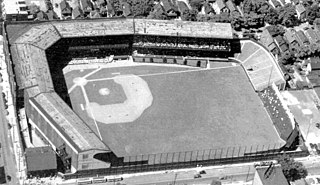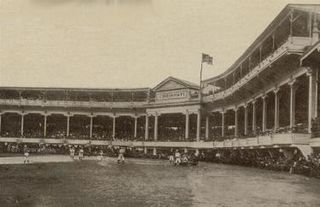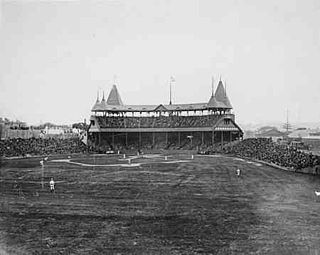
The Cincinnati Reds are an American professional baseball team based in Cincinnati. They compete in Major League Baseball (MLB) as a member club of the National League (NL) Central division and were a charter member of the American Association in 1881 before joining the NL in 1890.

Fenway Park is a baseball stadium located in Boston, Massachusetts, near Kenmore Square. Since 1912, it has been the home of the Boston Red Sox, the city's American League baseball team, and, since 1953, its only Major League Baseball (MLB) franchise. While the stadium was built in 1912, it was substantially rebuilt in 1934, and underwent major renovations and modifications in the 21st century. It is the oldest active ballpark in MLB. Because of its age and constrained location in Boston's dense Fenway–Kenmore neighborhood, the park has many quirky features, including "The Triangle", Pesky's Pole, and the Green Monster in left field. It is the fifth-smallest among MLB ballparks by seating capacity, second-smallest by total capacity, and one of eight that cannot accommodate at least 40,000 spectators.

Riverside Park, located in Dawson Springs, Kentucky, was originally built in 1914 to serve as a spring training park for the Pittsburgh Pirates from 1914 to 1917. Sometimes referred to as Tradewater Park, it is the only known baseball park in Kentucky to have hosted a major league team since the Louisville Colonels folded in 1899. While the original stadium was destroyed in a flood in the 1930s, it was later rebuilt in 1999. Like the original stadium, the rebuilt park is reconstructed out of wood. It is the only ballpark of its kind in Western Kentucky.
The American Association of Base Ball Clubs (AA) was a professional baseball league that existed for 10 seasons from 1882 to 1891. Together with the National League (NL), founded in 1876, the AA participated in an early version of the World Series seven times versus the champion of the NL in an interleague championship playoff tournament. At the end of its run, several AA franchises joined the NL. After 1891, the NL existed alone, with each season's champions being awarded the Temple Cup (1894–1897).

League Park was a baseball park located in Cleveland, Ohio, United States. It was situated at the northeast corner of Dunham Street and Lexington Avenue in the Hough neighborhood. It was built in 1891 as a wood structure and rebuilt using concrete and steel in 1910. The park was home to a number of professional sports teams, most notably the Cleveland Indians of Major League Baseball. League Park was first home to the Cleveland Spiders of the National League from 1891 to 1899 and of the Cleveland Lake Shores of the Western League, the minor league predecessor to the Indians, in 1900. From 1914 to 1915, League Park also hosted the Cleveland Spiders of the minor league American Association. In the late 1940s, the park was also the home field of the Cleveland Buckeyes of the Negro American League.

Crosley Field was a Major League Baseball park in Cincinnati, Ohio. It was the home field of the National League's Cincinnati Reds from 1912 through June 24, 1970, and the original Cincinnati Bengals football team, members of the second (1937) and third American Football League (1940–41). It was not the original home of the current NFL franchise of the same name: the home of those Bengals in 1968 and 1969 was nearby Nippert Stadium, located on the campus of the University of Cincinnati. Crosley Field was on an asymmetrical block bounded by Findlay Street (south), Western Avenue, Dalton Avenue (east), York Street (north) and McLean Avenue (west) in the Queensgate section of the city. Crosley has the distinction of being the first major-league park with lights for playing night games.

Palace of the Fans was a Major League baseball park located in Cincinnati, Ohio. It was the home of the Cincinnati Reds from 1902 through 1911. The ballpark was on an asymmetrical block bounded by Findlay Street (south), Western Avenue, York Street (north) and McLean Avenue (west).

South End Grounds refers to any one of three baseball parks on one site in Boston, Massachusetts. They were home to the franchise that eventually became known as the Boston Braves, first in the National Association and later in the National League, from 1871 to 1914.

Avenue Grounds was a baseball field located in Cincinnati, USA. Also known as Brighton Park and Cincinnati Baseball Park, the ground was home to the Cincinnati Reds baseball club from April 25, 1876, to August 27, 1879. The ballpark featured a grandstand that could seat up to 3,000 fans. It was approximately 2 miles (3.2 km) north of the Union Grounds, where the original professional team from the area, the Cincinnati Red Stockings played, and was approximately 4 miles (6.4 km) from the heart of the city, so horse-drawn streetcars and trains were a popular way to travel to the park. The ballpark had first opened in 1875, and would continue to be used for various types of amateur sports until at least the mid-1890s. The major league club of 1876–1879 played poorly, and actually dropped out of the league after the 1879 season ended. The club revived for 1880, and relocated to the Bank Street Grounds.
The Bank Street Grounds is a former baseball park located in Cincinnati. The park was home to three major league baseball teams. The National League Cincinnati Stars club in 1880, the current Cincinnati Reds franchise from 1882 to 1883 and the Cincinnati Outlaw Reds of the Union Association in 1884. It succeeded the Avenue Grounds as the home site for professional ball in the Queen City.

West Side Park was the name used for two different ballparks that formerly stood in Chicago, Illinois. They were both home fields of the team now known as the Chicago Cubs of the National League. Both ballparks hosted baseball championships. The latter of the two parks, where the franchise played for nearly a quarter century, was the home of the first two world champion Cubs teams, the team that posted the best winning percentage in Major League Baseball history and won the most games in National League history (1906), the only cross-town World Series in Chicago (1906), and the immortalized Tinker to Evers to Chance double-play combo. Both ballparks were primarily constructed of wood.

The Boston Reds were a 19th-century baseball team located in Boston, Massachusetts that played in the Players' League in 1890 and in the American Association in 1891. They played in the Congress Street Grounds in the 1890s. The team took its name from the successful Boston club of the National Association and National League often known as the (Boston) Red Stockings. The club lasted only two seasons, but in those two seasons they were league champions.

Centennial Field is the name of the baseball stadium at the University of Vermont in Burlington, Vermont, and is the home of the Vermont Lake Monsters.
Kelly's Killers were a Major League baseball team that played in Cincinnati, Ohio during the 1891 baseball season. The team played in the American Association, which was a major league from 1882 to 1891.
The following are the baseball events of the year 1912 throughout the world.
League Park was a Major League baseball park located in Cincinnati, Ohio, United States. It was the home of the Cincinnati Reds from 1884 through 1901. The ballpark was on an asymmetrical block bounded by Findlay Street (south), Western Avenue, York Street (north) and McLean Avenue (west).
The Lincoln Park Grounds, commonly known as Union Grounds, was a former baseball park, part of Lincoln Park, located in Cincinnati, Ohio. The Grounds were built for the Union Cricket Club in 1856; they "were used for cricket and baseball in the summer and were flooded for skating in the winter." In 1865 Harry Wright became the professional of the Cincinnati Cricket Club, which also used the grounds, and the next year Aaron Champion, president of the new Cincinnati Base Ball Club, "approached Wright to propose a limited use of the grounds if the CBBC and Live Oaks club would put in $2000 each to revamp the Lincoln Park Grounds."
A year later the [Red Stockings] leased the grounds of the Union Cricket Club for its home tilts. Most club members referred to the field as the Union Grounds, although it also was known as the Union Cricket Club Grounds and the Lincoln Park Grounds, given the fact that the eight-acre, fenced grounds were located in a small park behind Lincoln Park in Cincinnati, near the Union Terminal. It was a twenty-minute ride by streetcar to the Union Grounds from the heart of downtown Cincinnati. Aaron Champion ordered that approximately $10,000 worth of improvements be made to the home grounds for the 1867 season, including grading and sodding of the field and building of a new clubhouse and stands.

The Boston Reds were a Major League Baseball franchise that played in the Players' League (PL) in 1890, and one season in the American Association (AA) in 1891. In both seasons, the Reds were their league's champion, making them the second team to win back-to-back championships in two different leagues. The first franchise to accomplish this feat was the Brooklyn Bridegrooms, who won the AA championship in 1889 and the National League (NL) championship in 1890. The Reds played their home games at the Congress Street Grounds.

Oriole Park, often referred to as Terrapin Park, opened in 1914 and closed after a fire on July 3–4, 1944. "Oriole Park" was the name of multiple baseball parks in Baltimore, Maryland, all built within a few blocks of each other.















